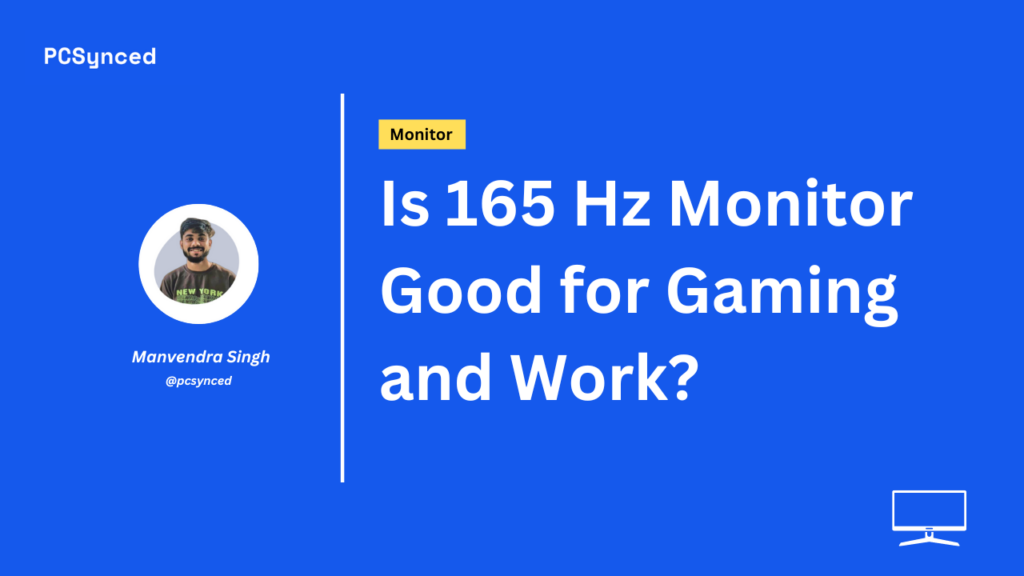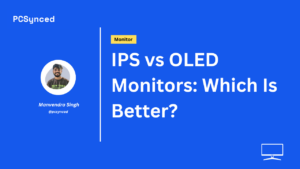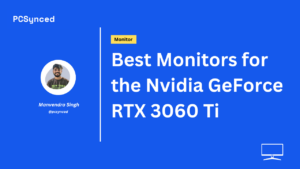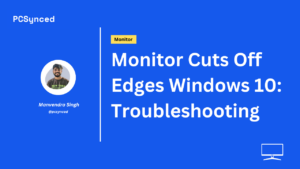About The Article:
- 165Hz monitors offer higher refresh rates than standard 60Hz displays.
- The article analyzes if 165Hz is good for gaming, by looking at frame rates, motion clarity.
- It also covers the benefits of 165Hz monitors for work – reducing eye strain, smoother scrolling.
- Key factors are discussed like GPU requirements, 165Hz vs 144Hz, whether 165Hz is overkill.
Written By – Manvendra Singh
Gaming monitors with high refresh rates, like 165 Hz, are becoming increasingly popular.
But is a 165 Hz monitor good for gaming and work?
Look at 165 Hz monitors and see if they are worth it.
Quick Answer:
Yes, a 165 Hz monitor offers smooth visuals ideal for gaming and provides enhanced refresh rates beneficial for work.

What is a 165 Hz Monitor?
The monitor’s refresh rate refers to how many times per second the monitor can redraw or refresh the image on the screen.
A standard 60 Hz monitor refreshes the image 60 times per second.
A 165 Hz monitor refreshes the image a very fast 165 times per second.
This high refresh rate allows the monitor to display more frames per second from your computer’s graphics card.
So on a 165 Hz monitor, you can see up to 165 fps (frames per second) rendered on screen if your graphics card is powerful enough.
Benefits of a 165 Hz Monitor
Here are some of the key benefits of using a 165 Hz gaming monitor compared to a standard 60 Hz monitor:
1. Smoother Gameplay
The main benefit is much smoother gameplay, especially in fast-paced competitive multiplayer games like first-person shooters.
The higher fps and refresh rate significantly reduces motion blur and input lag, making it easier to aim and react quickly and precisely.
2. Reduced Screen Tearing
Screen tearing happens when the monitor refresh rate is out of sync with the game’s frame rate.
A 165 Hz monitor is less prone to screen tearing thanks to higher refresh rates and technologies like G-Sync or FreeSync, which match the monitor and GPU frames.
3. More Responsive Experience
165 Hz results in lower input lag or delay between pressing a key and seeing the result on the screen.
This lag is reduced from an average of 20-50 ms on a 60 Hz monitor down to just 5-10 ms on a 165 Hz monitor.
4. Better for High FPS Gaming
You need a monitor that matches and displays all those frames to take full advantage of high frame-rate gaming.
A 165 Hz monitor lets you experience buttery smooth 140+ fps gameplay from high-end GPUs.
5. More Future Proof
A 165 Hz monitor will remain relevant for many years as GPUs get more powerful.
You can utilize the full potential of future upgrades without needing to upgrade your monitor again.
Is a 165 Hz Monitor Good for Work?
While not as impactful as for gaming, a 165 Hz monitor can provide some benefits for general desktop usage and work:
- Smoother scrolling through documents and web pages
- Less eye strain from flickering and blurring
- Crisper text and UI elements
- Better for viewing fast-moving video or animation
The higher refresh rate helps avoid lag and tearing when quickly moving through spreadsheets or documents.
So a 165 Hz monitor can make work feel more fluid and responsive.
However, a 165 Hz monitor may be overkill for general office work and productivity.
Many users are OK with standard 60-75 Hz monitors for work. But if you also want to do gaming, a 165 Hz monitor can serve both purposes well.
What to Look for in a 165 Hz Gaming Monitor
Here are some key features to look for if considering a 165 Hz gaming monitor:
- Panel Type: The best options are IPS or VA panels with good colour, viewing angles and response times. Avoid cheaper TN panels.
- Resolution: 1080p is the most common for high-refresh gaming. 1440p 165Hz monitors are ideal but also more expensive.
- Adaptive Sync: G-Sync or FreeSync prevent screen tearing and allow 165 Hz to be fully utilized.
- Response Time: Aim for 1 ms or lower response time to eliminate ghosting and blurring.
- Size: 24″ to 27″ are standard eSports gaming sizes. 32″ monitors are also available if you prefer more screen space.
- Ports: Look for HDMI 2.0 and DisplayPort 1.2, which allow 165 Hz at 1080p and 1440p. Avoid monitors with only DVI or VGA.
- Curved: A 1500R or 1800R curve helps with immersion on larger monitors but is optional.
Budget 165 Hz Gaming Monitors
Here are some of the best 165 Hz monitors available under $300:
- Acer Nitro XV252QF – 24.5″, 1080p, IPS panel with 99% sRGB colour accuracy. Great value 165 Hz monitor with FreeSync.
- Asus VG248QG – 24″, 1080p, 0.5ms response time. It’s one of the cheapest G-Sync-compatible 165 Hz monitors.
- MSI Optix G241 – 23.8″ IPS panel with 95% DCI-P3 comprehensive colour gamut coverage. Great for both gaming and content creation.
- ViewSonic XG2405 – 24″ monitor with HDMI 2.0 and DisplayPort input. It also has a 75 Hz mode for non-gaming use.
Is a 240Hz or 360Hz Monitor Better?
240Hz and 360Hz monitors push refresh rates even higher than 165Hz.
They can offer a slight competitive advantage in ultra-fast-paced shooters.
But for most gamers, a 165 Hz monitor delivers a superb experience at a more affordable price point.
Consider 240Hz+ monitors if you are an extremely competitive esports gamer or want the absolute smoothest experience possible.
But for most gamers and users, a 165 Hz monitor strikes the best balance.
Conclusion
A 165 Hz gaming monitor can significantly improve smoothness, responsiveness and visual clarity compared to standard 60 Hz monitors.
The high refresh rate helps fully unlock the potential of powerful GPUs.
While not essential, a 165 Hz monitor gives a tremendous competitive advantage in multiplayer games.
The difference is immediately apparent when switching from 60 Hz.
They also provide benefits for general desktop usage, like smoother scrolling and video playback.
When shopping for a 165 Hz monitor, look for features like IPS/VA panels, FreeSync or G-Sync, 1ms response time and the latest display connectors.
A 165 Hz monitor is an excellent and responsive gaming monitor with the right parts.
FAQ
Ques 1: Is a 165Hz monitor worth it?
Ans: For gaming, a 165Hz monitor is worth it. The much higher refresh rate makes motion look incredibly smooth, and gameplay becomes very responsive.
It provides a significant competitive advantage in multiplayer games.
A 60-75Hz monitor is fine for everyday usage, but 165Hz is excellent if you want a fluid and lag-free experience.
Ques 2: Can the human eye see 165 fps?
Ans: The human eye can’t see distinct individual frames above 60 fps.
However, up to at least 150 fps, there are benefits to displaying more frames like reduced input lag and much smoother motion clarity.
So while we can’t see 165 fps per se, a 165Hz monitor does provide visual benefits compared to 60Hz.
Ques 3: Is 1440p or 165Hz more important for gaming?
Ans: A higher refresh rate of 165Hz is more important than resolution for competitive multiplayer gaming like FPS games.
For slower-paced story games, 1440p provides much sharper image quality.
A 1440p 165Hz monitor is ideal but also more expensive. For most gamers on a budget, 1080p 165Hz represents the best bang for the buck.
Ques 4: How long do 165Hz monitors last?
Ans: A high-quality 165Hz monitor can last 5-7 years or longer with proper care.
The refresh rate doesn’t impact lifespan – things like build quality and panel hours, determine how long a monitor lasts before degrading performance.
As long as the monitor is not abused, it should last many years, even with heavy daily use.
Ques 5: Is 144Hz the same as 165Hz?
Ans: 144Hz vs 165Hz are quite similar, and both are far better than 60Hz.
That extra 21Hz from 144Hz to 165Hz provides a minor incremental improvement in smoothness but is likely, not noticeable for most users.
Either 144Hz or 165Hz represent a great upgrade over standard monitors for gaming. So get whichever provides the best overall features and value.








